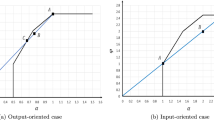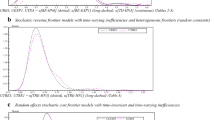Abstract
This paper deals with estimation of a production technology where endogeneous choice of input and output variables is explicitly recognized. In particular, we assume that producers maximize return to the outlay (RO). For simplicity and tractability we start with a Cobb–Douglas transformation function with multiple inputs and outputs and show how the first-order conditions of RO maximization can be used to derive an estimating equation which is nothing but a partial input productivity equation. This equation does not suffer from the econometric endogeneity problem although the output and input variables are endogenous. First, we consider the case where producers are fully efficient allocatively but technically inefficient. The model is estimated using a single equation stochastic frontier approach. The model is then extended to allow allocative inefficiency and it is estimated as a system using generalized method of moment. Algebraic expressions are derived to decompose the effect of technical and allocative inefficiencies on RO. We also consider translog specifications that are estimated as (1) a single equation frontier model as well as (2) a system. We use a panel of Norwegian fishing trawlers data to estimate the model. Outputs are different species caught while inputs are labor and vessel size. We also control for number of days of operation, age of the vessel and year effects. Empirical results show that the average rate of RO is reduced by about 20 to 30 % due to technical inefficiency. On the other hand, average allocative efficiency is found to be about 78 %. The average overall efficiency is found to be around 60 %.








Similar content being viewed by others
Notes
There are many efficiency papers published in the operational research journals (for example, Reinhard et al. (2000), Brissimis et al. (2010), among many others). Since most of these papers use data envelopment analysis, which is a linear programming technique, there is no endogeneity issue in estimation even if some explicit economic behaviors are modeled.
For example, endogeneity issue is discussed in many papers (Coelli 2000; Kumbhakar 2001, 2011, among many others) under profit maximization behavior. Endogeneity in the context of a distance function using system approach under profit maximization behavior is discussed in Karagiannis et al. (2006) and Coelli et al. (2007).
We are excluding the cases in which technical and/or allocative inefficiency are formulated as either fixed parameters or deterministic functions. These are often labeled as shadow price models, and are discussed under revenue and profit maximization behaviors. See chapter 6 of Kumbhakar and Lovell (2000) for a discussion of these models. Although the shadow system with RO maximization might be somewhat similar to the system under cost minimization and profit maximization, we are not aware of any such paper.
Note that these normalizing constraints make the transformation function homogeneous of degree one in outputs. In the efficiency literature one starts from a distance function (which is the transformation function with inefficiency built in) and imposes linear homogeneity (in outputs) constraints to get the ODF. Here we get the same end-result without using the notion of a distance function to start with.
These normalizing constraints make the transformation function homogeneous of degree one in inputs. In the efficiency literature one defines the IDF as the distance (transformation) function which is homogeneous of degree one in inputs. Here we view the homogeneity property as identifying restrictions on the transformation function without using the notion of a distance function.
See Coelli (2000) for a discussion on the endogeneity issue under profit maximizing, cost minimizing and revenue maximizing behaviors.
The basic idea of this goes back to Georgescu-Roegen’s (1951) notion of “return to the dollar”.
The restrictions ∑ j β j = −1 and ∑ m α m = 1 make RTS unity. Note that unitary RTS is not an assumption. It is an implication of maximizing RO. If RTS is unity, the inefficiency can be given a hyperbolic interpretation as shown in Section 2. RTS in terms of the transformation function without inefficiency is defined as \(\sum_j \partial \ln f(\cdot)/ \partial \ln x_j \div \sum_m \partial \ln f(\cdot)/ \partial \ln y_m\) (Panzar and Willig 1977), where \(f(\cdot)\) is the transformation frontier.
Although the inefficiency term in our estimating equation is exactly the same as the inefficiency term in the hyperbolic ODF in (5), from estimation point of view the specification in (11) is preferred because the regressors in it are all in ratio forms and they can be treated as exogenous under RO maximization.
Alternatively one can use OLS or 2SLS to (11) in which ratios of input and output prices and the Z variables can be used as instruments. This is suggested in Kumbhakar and Lovell (2000) as well several other papers such as Kumbhakar and Hjalmarsson (1995), Kumbhakar and Heshmati (1997), among others. It is also possible to use the system approach such as 3SLS. The advantage of GMM is that it is robust to heteroskedastic errors.
Individual parameters of the translog function do not have any direct meaning/interpretation. Because of this we have not reported the estimated parameters. However, we used the estimated parameters to compute output elasticities and technical change. These results are discussed later in this section.
References
Asche F (2009) Adjustment cost and supply response: a dynamic revenue function. Land Econ 85:201–215
Asche F, Bjørndal T, Gordon DV (2009) Resource rent in individual quota fisheries. Land Econ 85:280–292
Asche F, Gordon DV, Jensen CL (2007) Individual vessel quotas and increased fishing pressure on unregulated species. Land Econ 83:41–49
Brissimis SN, Delis MD, Tsionas EG (2010) Technical and allocative efficiency in European banking. Eur J Oper Res 204:153–163
Coelli TJ (2000) On the econometric estimation of the distance function representation of a production technology. Discussion Paper 2000/42, Center for Operations Research and Econometrics, Universite Catholique de Louvain
Coelli TJ, Hajargasht G, Lovell CAK (2007) Econometric estimation of an input distance function in a system of equations. Unpublished Paper, Universsity of Queensland, Brisbane, Australia
Dupont DP (1990) Rent dissipation in restricted access fisheries. J Environ Econ Manag 19:26–44
Färe R, Grosskopf S, Zaman O (2002) Hyperbolic efficiency and return to the dollar. Eur J Oper Res 136:671–679
Georgescu-Roegen N (1951) The aggregate linear production function and its applications to von Neumann’s economic model. In: Koopmans T (eds) Activity analysis of production and allocation. Wiley, New York, pp 98–115
Grafton Q, Squires D, Fox K (2000) Private property and economic inefficiency: a study of a common-pool resource. J Law Econ 43:679–713
Grifell-Tatjé E, Lovell CAK (1999) Profits and productivity. Manag Sci 45:1177–1193
Guttormsen AG, Roll KH (2011) Technical Efficiency in a Heterogeneous Fishery. Mar Res Econ 26:293–208
Homans FR, Wilen JE (2005) Markets and rent dissipation in regulated open access fisheries. J Environ Econ Manag 49:381–404
Jondrow J, Lovell CAK, Materov IS, Schmidt P (1982) On the estimation of technical inefficiency in the stochastic frontier production function model. J Econom 19:233–38
Karagiannis G, Tsionas EG, Kumbhakar SC (2006) Estimation of input distance functions in the presence of technical and allocative inefficiency: a system approach. Working paper, State University of New York at Binghamton, New York
Kirkley JE, Squires D, Strand I (1995) Assessing technical efficiency in commercial fisheries: the mid-Atlantic sea scallop fishery. Am J Agric Econ 77:686–697
Kirley J, Morrison Paul CJ, Squires D (2004) Deterministic and stochastic capacity estimation for fishery capacity reduction. Mar Res Econ 19:271–294
Kirkeley J, Squires D, Strand I (1998) Characterizing manegerial skill and technical efficiency in a fishery. J Prod Anal 9:145–160
Kumbhakar SC (2001) Estimation of profit function when profit is not maximum. Am J Agric Econ 83:1–19
Kumbhakar SC (2011) Estimation of production technology when the objective is to maximize return to the outlay. Eur J Oper Res 208:170–176
Kumbhakar SC, Heshmati A (1997) Estimation of technical efficiency in Swedish crop farms: a pseudo panel data approach. J Agric Econom 48:22–37
Kumbhakar SC, Hjalmarsson L (1995) Decomposing technical change with panel data: an application to the public sector. Scand J Econom 97:309–323
Kumbhakar SC, Lien G (2010) Productivity and profitability decomposition: a parametric distance function approach. Food Econ Acta Agric Scand 6:143–155
Kumbhakar SC, Lovell CAK (2000) Stochastic frontier analysis. Cambridge University Press, Cambridge
Miller DM, Rao PM (1989) Analysis of profit-linked total-factor productivity measurement models at the firm level. Manag Sci 35:757–767
Nerlove M (1965) Estimation and identification of Cobb–Douglas production functions. Rand McNally & Company, Chicago
Panzar JC, Willig RD (1977) Economies of scale in multi-output production. Q J Econ 91:481–493
Pascoe S, Cogland L (2002) The contribution of unmeasurable inputs to fisheries production: an analysis of technical efficiency of fishing vessels in the English Channel. Am J Agric Econ 84:585–597
Reinhard S, Lovell CAK, Thijssen GJ (2000) Environmental efficiency with multiple environmentally detrimental variables; estimated with SFA and DEA. Eur J Oper Res 121:287–303
Schmidt P, Lovell CAK (1979) Estimating technical and allocative ineficiency relative to stochastic production and cost frontiers. J Econom 9:343–366
Squires D (1987) Long-run profit functions for multiproduct firms. Am J Agric Econ 69:558–569
Squires D (1988) Production technology, costs, and multiproduct industry structure: an application of the long-run profit function to the New England fishing industry. Can J Econ 21:359–378
Squires D, Kirkley JE (1991) Production quota in multiproduct pacific fisheries. J Environ Econ Manag 21:109–126
Valderrama D, Anderson JL (2010) Market interactions between aquaculture and common-property fisheries: recent evidence from the Bristol Bay sockeye salmon fishery in Alaska. J Environ Econ Manag 59:115–128
Wang Hung-Jen (2002) Heteroscedasticity and Non-Monotonic Efficiency Effects of a Stochastic Frontier Model. J Prod Anal 18:241–253
Weninger Q (1999) Assessing efficiency gains from individual transferable quotas: an application to the mid-Atlantic surf clam and ocean quahog fishery. Am J Agric Econ 81:750–764
Weninger Q, Waters JR (2003) Economic benefits of management reform in the northern gulf of Mexico reef fish fishery. J Environ Econ Manag 46:207–230
Yu M-M, Fan C-K (2008) The effects of privatization on return to the dollar: a case study on technical efficiency, and price distortions of Taiwan’s intercity bus services. Transp Res A Policy Pract 42:935–950
Zofío J, Prieto A (2006) Return to dollar, generalized distance function and the Fisher productivity index. Span Econ Rev 8:113–138
Author information
Authors and Affiliations
Corresponding author
Rights and permissions
About this article
Cite this article
Kumbhakar, S.C., Asche, F. & Tveteras, R. Estimation and decomposition of inefficiency when producers maximize return to the outlay: an application to Norwegian fishing trawlers. J Prod Anal 40, 307–321 (2013). https://doi.org/10.1007/s11123-012-0336-5
Published:
Issue Date:
DOI: https://doi.org/10.1007/s11123-012-0336-5






